
EEG Unit

What Is an EEG?
Electroencephalography (EEG) is an electrophysiological monitoring method to record electrical activity of the brain. It is typically non-invasive, with the electrodes placed along the scalp, although invasive electrodes are sometimes used in specific applications. EEG measures voltage fluctuations resulting from ionic current within the neurons of the brain. In clinical contexts, EEG refers to the recording of the brain's spontaneous electrical activity over a period of time, as recorded from multiple electrodes placed on the scalp. Diagnostic applications generally focus on the spectral content of EEG, that is, the type of neural oscillations (popularly called "brain waves") that can be observed in EEG signals.
Special Application of EEG
- Long term EEG
- Video EEG Monitoring
- Sleep EEG
- Polysomnography
- Intra Operative Monitoring (IOM)
Why Is an EEG Performed?
Any Seizure disorder like,
- Generalize tonic clonic seizure (GTC)
- Temporal lobe epilepsy (TLE)
- Occipital lobe epilepsy (OLE)
- Parital lobe epilepsy
- Frontal lobe epilepsy
- Afebrile convulsion
- Electrical status epilepsy (ESES)
- Lennox gastaut syndrome (LGS)
- Angleman syndrome
- Rett syndrome
- Sub sclerosis pan epileptic (SSPE)
- Neonatal convulsions
- Infantile spasm/ Hypsarrythmia
- Focal epilelepsy1
- Abscense seizure
- Myoclonic epilepsy
- Benign rolandic epilepsy
- Idiopathic epilepsy
- Head injury
- Encephalitis
- Brain tumor
- Encephalopathy
- Memory problems
- Sleep disorders such as narcolepsy
- Severe Headache/ Migraine
- When someone is in a coma
- Mental health problem
- Change inconsciousness (sudden behavior change)
- Fainting attacks
- Autism, GDD
An EEG may also be used to confirm brain death in someone in a persistent coma. A continuous EEG is used to help find the right level of anesthesia for someone in a medically induced coma.
How Do Prepare for an EEG?
- Wash your hair the night before the EEG, and don’t put any products (such as sprays or gels) in your hair on the day of the test.
- Do not stop taking medications and meals.Ask your doctor if you should stop taking any medications before the test. You should also make a list of your medications and give it to the technician performing the EEG.
- Your doctor may ask you to sleep as little as possible the night before the test if you’re required to sleep during the EEG. You may also be given a sedative to help you to relax and sleep before the test begins.
- After the EEG is over, you can continue with your regular routine for the day.
What are the risks of an EEG?
The EEG has been used for many years and is considered a safe procedure. The test causes no discomfort. The electrodes record activity. They do not produce any sensation. In addition, there is no risk of getting an electric shock.
In rare instances, an EEG can cause seizures in a person with a seizure disorder. This is due to the flashing lights or the deep breathing that may be involved during the test. If you do get a seizure, your healthcare provider will treat it immediately.
Other risks may be present, depending on your specific medical condition. Be sure to discuss any concerns with your healthcare provider before the procedure.
Certain factors or conditions may interfere with the reading of an EEG test. These include:
- Low blood sugar (hypoglycemia) caused by fasting
- Body or eye movement during the tests (but this will rarely, if ever, significantly interfere with the interpretation of the test)
- Lights, especially bright or flashing ones
- Certain medicines, such as sedatives
- Drinks containing caffeine, such as coffee, cola, and tea (while these drinks can occasionally alter the EEG results, this almost never interferes significantly with the interpretation of the test)
- Oily hair or the presence of hair spray
What Do the EEG Test Results Mean?
A neurologist (someone who specializes in nervous system disorders) interprets the ecordings taken from the EEG and then sends the results to your doctor. Your doctor may schedule an appointment to go over the test results with you.
Normal Results
Electrical activity in the brain is seen in an EEG as a pattern of waves. Different levels of consciousness, such as sleeping and waking, have a specific range of frequencies of waves per second that are considered normal. For example, the wave patterns move faster when you’re awake than when you’re asleep. The EEG will show if the frequency of waves or patterns are normal. Normal activity typically means you don’t have a brain disorder.
Abnormal Results
Abnormal EEG results may be due to:
- epilepsy or another seizure disorder
- abnormal bleeding or hemorrhage
- sleep disorder
- encephalitis (swelling of the brain)
- a tumor
- dead tissue due to a blockage of blood flow
- migraines
- alcohol or drug abuse
- head injury
It’s very important to discuss your test results with your doctor. Before you review the results with them, it may be helpful to write down any questions you might want to ask. Be sure to speak up if there’s anything about your results that you don’t understand.
What happens after an EEG
When the test is finished, the electrodes will be removed and your scalp will be cleaned. Your hair will probably still be a bit sticky and messy afterwards, so you may want to wash it when you get home.
You can usually go home soon after the test is finished and can return to your normal activities. You might feel tired after the test, particularly if you had a sleep or sleep-deprived EEG, so you may want someone to pick you up from hospital.
Your Care Team
The EEG Unit consists of trained and government qualified technicians , trained nursing and support staff.